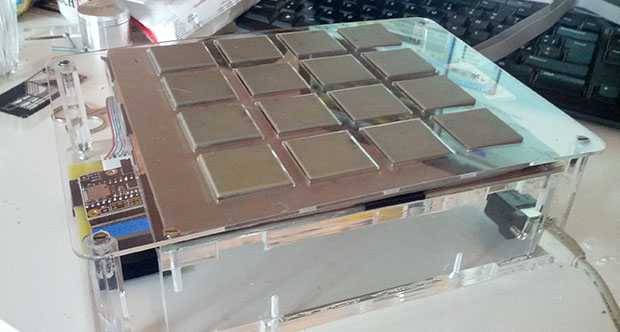A staple of every recording studio today, the Akai MPC began as a simple sampling groove box in the early 90s. The form factor of a few force sensitive pads assignable to different samples should be familiar to anyone with a little bit of MIDI gear, but these are rarely custom-made devices. Now, it runs on a Teensy. [Michele] created his own MPC-style MIDI pad controller with the Teensy 3.0, the Teensy audio adapter board, and an ingenious PCB design that uses replacement MPC pads.
[Michele]’s MPC was first featured in the MIDI hacklet, but back then the only working component was the pads themselves. The velocity sensitive pads are made of two copper traces laid on a single acetate sheet. A bit of Velostat is glued to the back of the pad so when the pad is pressed, it contacts both of the traces. The harder the pad is pressed, the lower the impedance, and with everything sent to an analog pin, each pad becomes a force sensitive resistor.
With the key feature of an MPC taken care of, [Michele] turned his attention to the sampling and software of his device. The new Teensy 3.0 audio adapter board – and a great new library – takes care of everything. [Michele] doesn’t have a proper video of his MPC up yet, but he was able to film a random guy playing his machine at Rome Maker Faire yesterday. You can check that out below.
















Cool, new Jubeat controller ^_^
http://www.gamo2.com/en/index.php?dispatch=products.view&product_id=310
Hey guys,
I would like to point out that it still does not work as a standalone MPC, but it can easily become one; you only have to mod the code so to trigger samples rather than MIDI notes. Or, you can program your very own synth and use the pads to play its notes. Finally, you can just remove the audio adaptor compatibility and control up to 9 multiplexers, that’s more than 128 analog controls!
Cheers,
Mick
There is some obvious utility here, but I scorn what has happened to music at the hands of people playing tidbits of someone elses music and calling it their own or playing a few notes on a square keypad with 16 keys.
http://youtu.be/Ybw_W-UlO10
The new version is a chick with a looper pedal. They regularly sell out venues around here :( More than enough “Come see my laptop perform” shows out there as well (I think Traktor has killed even djing lol). Then you have any number of folks that spin two discs of someone else’s music and get glory for twisting a bass eq knob. I reckon the rooskie analog jam session is pretty real and good, though. I guess to each their own. I just have my three Kraftwelt albums on loop with some old DJ Deadly Buda for inspiration and the synths for the rest, although as I get older it gets less NIN and more Eno lol. I’m sure that other musicians said the same of the arpeggiator back in the day.
This is not to demean the above project in any way (I love MIDI) and it is a nice starting point for someone to learn the ins and outs of synthesis and uprocs. Best to ya, Mick and keep jamming!
Maybe you should scorn any instrument or musician then? After all, there are only so many sounds which are audible and pleasant to us in the frequency spectrum humans can hear. Since the set of notes is finite, the set of combinations is too. Which combinations sound nice in what sequence is probably a more limited set. If said set is small enough, then there probably isn’t much difference between someone writing their own music from “scratch” and someone else starting with combinations and working their way up to a whole piece aside from the time required to reach that point. They’re both going to choose something that sounds good or interesting and probably there will be some people will highly similar pieces.
What gives anyone else a claim to an arrangement of notes anyway? The more you break it down, the less it really is anyone’s music. We could argue about lyrics maybe, but the sounds well… How far down (smaller and smaller chunks) can you really go before you hit the combinations I’m talking about?
A day people will sum sine ans square waves and call it sound …
I’d rather listen to a nice remix made with samples took from different songs played with an instrument like mine, than listening to a “real” musician that plays the same chords that have been played a zillion times for the last 300 years (see: Pachelbel’s Canon in D). I personally call “artists” the first kind of people, not the second.
Anyway, such project could be used not only to play music in a fast way, by mashing buttons and setting premade scale patterns on the run, but also to create huge and complex custom control surfaces for professional studio equipment.
Finally, this kind of project, while surely aimed to musicians and producers alike, is here to give the possibility to hackers/makers to create custom MIDI controls and sensitive pads in a cheap and easy way.